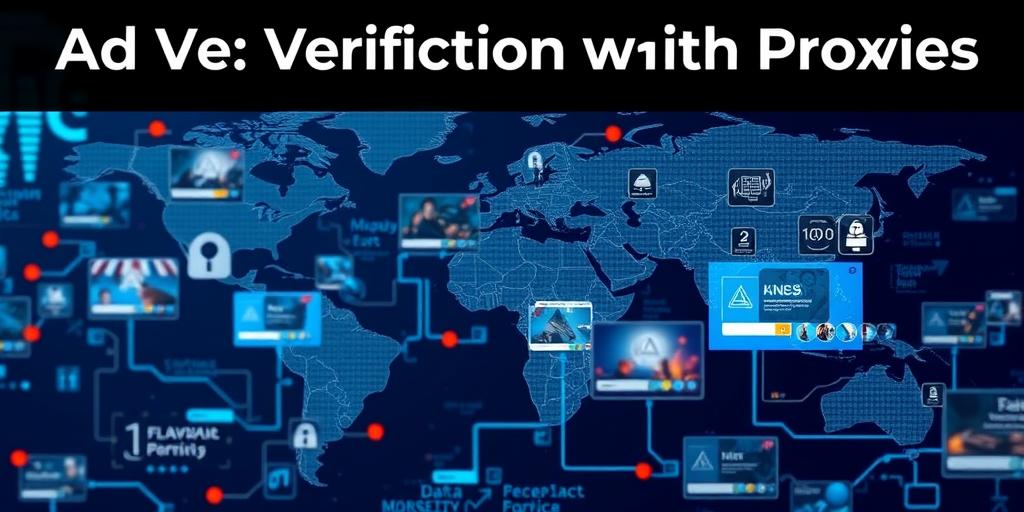Ad Verification with Proxies: Ensure Your Campaigns Run as Intended
In the digital advertising world, ensuring your campaigns are running as intended is crucial for maximizing your ROI. Ad verification is the process of confirming that your ads are displayed to the right audience, in the right context, and without any fraudulent activity. One effective method for enhancing ad verification is through the use of proxies. This article will explore how proxies can help you ensure your campaigns run as intended.
What is Ad Verification?
Ad verification involves monitoring and analyzing various aspects of your ad campaigns to ensure they meet your objectives. This includes:
- Placement Verification: Confirming that your ads are appearing on the intended websites and in the correct ad slots.
- Audience Verification: Ensuring that your ads are being shown to the demographic and geographic targets you've specified.
- Brand Safety: Verifying that your ads are not appearing alongside inappropriate or harmful content.
- Fraud Detection: Identifying and preventing ad fraud, such as bot traffic and fake impressions.
Why Use Proxies for Ad Verification?
Proxies act as intermediaries between your computer and the internet, masking your IP address and providing a different geographic location. Here’s how they assist in ad verification:
- Geographic Accuracy: Proxies allow you to view ads as they appear in different geographic locations. This is essential for verifying that your geo-targeting settings are accurate and that your ads are reaching the intended audience in each region.
- Bypass Geo-Restrictions: Some websites or ad networks may restrict access based on location. Proxies enable you to bypass these restrictions and view ads as if you were a local user.
- Ad Placement Verification: By using proxies from different locations, you can confirm that your ads are appearing on the correct websites and in the appropriate ad slots, regardless of your actual location.
- Competitor Analysis: Proxies can help you monitor your competitors' ad campaigns in different regions. By viewing ads through various proxy servers, you can gather insights into their strategies and tactics.
- Fraud Detection: Proxies can assist in identifying suspicious activity and bot traffic. By routing your ad verification checks through proxies, you can detect discrepancies and potential fraud more effectively.
Types of Proxies for Ad Verification
When choosing proxies for ad verification, consider the following types:
- Residential Proxies: These proxies use IP addresses assigned to real residential locations, making them less likely to be detected as proxies. They are ideal for tasks that require high levels of trust and anonymity.
- Datacenter Proxies: These proxies come from data centers and are typically faster but more easily detected. They are suitable for tasks where speed is more critical than anonymity.
- Mobile Proxies: These proxies use IP addresses from mobile devices, offering a high level of anonymity and trust. They are useful for verifying ads on mobile platforms and apps.
How to Implement Proxies for Ad Verification
- Choose a Reliable Proxy Provider: Select a reputable proxy provider that offers a variety of proxy types and locations. Ensure they have a track record of reliability and security.
- Configure Your Verification Tools: Integrate the proxies with your ad verification tools. This may involve setting up the proxies in your web browser, ad monitoring software, or custom scripts.
- Rotate Proxies Regularly: To avoid detection and maintain anonymity, rotate your proxies regularly. This can be done manually or through automated proxy management tools.
- Monitor Proxy Performance: Keep an eye on the performance of your proxies, including their speed and uptime. Replace any proxies that are consistently slow or unreliable.
- Verify Ad Placement and Targeting: Use the proxies to access websites and ad platforms from different locations. Verify that your ads are appearing in the correct locations and to the intended audience.
Best Practices for Ad Verification with Proxies
- Use a Mix of Proxy Types: Combining different types of proxies (residential, datacenter, and mobile) can provide a more comprehensive and reliable ad verification process.
- Automate Proxy Management: Use proxy management tools to automate tasks such as proxy rotation, testing, and replacement.
- Monitor Ad Performance: Continuously monitor the performance of your ad campaigns and adjust your strategies as needed. Use the data gathered through ad verification to optimize your targeting and placement.
- Stay Updated on Ad Fraud Trends: Keep informed about the latest ad fraud techniques and adjust your verification methods accordingly. Ad fraud is constantly evolving, so it’s essential to stay vigilant.
Conclusion
Ad verification with proxies is a powerful method for ensuring that your ad campaigns run as intended. By using proxies to verify ad placement, audience targeting, and brand safety, you can optimize your campaigns for maximum ROI and protect yourself from ad fraud. Implementing the best practices outlined in this article will help you enhance your ad verification process and achieve your advertising goals.









